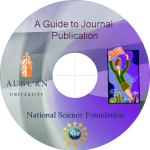

Related Literature
To the authors' knowledge these efforts are a first attempt to provide publication advice to the engineering academic audience. This is not to say that the scientific literature is void of publication advice. In fact, several excellent resources are available. Texts summarizing the publication process from a general readership perspective include McCloskey (1987), Cantor (1993), Silverman (1999), and Luey (2002). Additionally, several articles directed towards economics, finance, management, and accounting researchers may also be found.
Publication Advice and Acceptance Indicators
Zivney and Bertin (1992) studied the performance of 1,127 finance PhD's over a 25-year period and their contribution to 128 different archival journals. Many key insights in terms of publication quantity and quality were identified and discussed. One interesting finding is the total number of publications that finance academics have actually achieved (versus perceived in the finance 'publish or perish' world). Of the 1,127 finance doctorates, the 90th percentile number of publications after 5 years is 7 papers and after 20 years is 19 papers, the 75th percentile after 5 years is 4 papers and after 20 years is 9 papers, and the 50th percentile after 5 years is 2 papers and after 20 years is 4 papers. These findings suggest that "publishing one article per year in any finance-related journal over a prolonged period of time is a truly remarkable feat, met only by 5% of the graduates."
Mitenko and Diamond (1994) survey journal editors to examine the publication policies and practices of 25 finance journals. An aggregate acceptance rate across the 25 journals of approximately 20% was observed. Additionally, the following were identified (in order) as reasons for paper rejection: analytical errors, inappropriate journal submission, poorly written, lack of contribution, and inadequate explanation. The editors also provided the following advice to improve acceptance (in order): become familiar with the target journal, write concisely and clearly, clearly identify contribution to field, analyze data properly, and prepare a succinct abstract.
Henderson and Reichenstein (1996) surveys editors and reviewers in finance 'practitioner-oriented' journals concerning reasons for paper rejection. Listed in order frequency are: failed contribution, poor organization, poorly written, inappropriate journal, poorly linked results, and failure to motivate properly.
Chow and Harrison (1998) surveyed 119 influential accounting researchers to ascertain the most important factors for publishing success. Listed in order of frequency are: write clearly and concisely, utilize appropriate research skills, make a contribution, select a relevant topic, and remain persistent.
Henderson and Reichenstien (1998) acquire advice from the 50 most-cited authors in the top four finance journals. The following factors were identified for publication success (in order): better development and test of an existing idea or topic, ability to tell an economic story and relate quantitative results to that story, ability to find a gap in the literature as opposed to extending the research frontier, careful paper organization, and clearly written. The following rejection factors were also identified (in order): lack of contribution to the field, poor motivation, poor organization, poorly written, and failure to link results with economic story.
Koh (2003) explores how information system researchers view the journal review and publication process based on their professional status, institutional mission, and role orientation. He also addresses frequency of article submissions, acceptance/rejection rates, number of revisions required before publication, and publication outlets. Of the 122 survey respondents, an average acceptance rate of 60% was observed with 12% of papers accepted without revision, 27% accepted with one revision, 15% accepted with two revisions, and 6% accepted with more than two revisions. The 122 respondents have submitted 1,098 papers over the last three years, or on average three papers per year. The total review time averages 4 months with 2 months for the initial review and 2 months for subsequent reviews.
Gender Differences
Dwyer (1994) studied gender differences in the scholarly activities of accounting academics. The study indicated that women had significantly fewer publications in academic journals versus men. However, women and men received virtually equivalent number of total citations: this suggests that although women produce fewer papers than men, the total impact of women's papers is as great as the total impact of men's papers.
Streuly and Maranto (1994) study gender differences as they related to publication productivity and academic career advancement in the accounting area. They conclude that women are as productive as men when controlling for doctoral training and faculty appointment; thus, research performance should not be a barrier to the upward career mobility of women.
Collins, Parrish, and Collins (1998) study gender and the tenure track in the accounting field. Their key findings indicate little evidence of gender differences for women making tenure versus men. However, they did find that female faculty were significantly less likely to be hired at doctoral-granting institutions for their first position versus men. Thus, women are achieving same tenure rates as men, just at different types of institutions.
